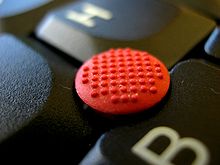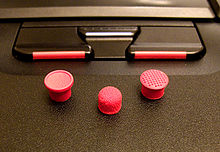- Pointing stick
-
This article is about a computer input device. For the teaching and presentation aid, see Pointer (rod).
The pointing stick (trademarked by IBM as the TrackPoint and by Synaptics as the TouchStyk) is an isometric joystick used as a pointing device (compare especially touchpad and trackball). It was invented by research scientist Ted Selker. It is present on many brands of laptops, including Lenovo's line of ThinkPad laptops, Toshiba Tecra laptops, HP business notebooks and on Dell Latitudes under the name of Track Stick. It has also been used on computer mice and on some desktop keyboards (as an integrated pointing device).
The pointing stick operates by sensing applied force (hence it is also known as an isometric joystick), by using a pair of resistive strain gauges. The velocity of the cursor depends on the applied force. On a QWERTY keyboard, the stick is embedded between the 'G', 'H' and 'B' keys, and the mouse buttons are placed just below the Spacebar. The mouse buttons can be operated right-handed or left-handed due to their placement below the keyboard along the centerline.
The pointing stick has a replaceable rubber cap, traditionally red on the ThinkPad but also found in other colors on other machines. The cap can be a slightly rough "eraser head" material (Classic Dome) or other optional shapes (Soft Dome or Soft Rim).[1]
Contents
Features
The sensitivity of the TrackPoint is usually adjustable, and can be set to provide an extremely light touch.
Press-to-select is an optional feature, where a sharp tap on the pointing stick is equivalent to a button-click. The button thus clicked can be configured to be 1, 2 or 3. However, it is quite easy to accidentally click the mouse when typing.
Together with software wheel-emulation, the Trackpoint (and 3 buttons) can provide almost the entire behavior of a 3-button, 2-wheel mouse. Tapping button-2 will generate a middle-click; holding button-2 while simultaneously moving the pointer will generate vertical and horizontal scrolling events.
The TrackPoint III and the TrackPoint IV have a feature called Negative Inertia that causes the cursor's velocity to "overreact" when it is accelerated or decelerated. Negative Inertia is intended to avoid feeling of inertia or sluggishness when starting or stopping movement.[2] Usability tests at IBM have shown that it is easier for users to position the cursor with Negative Inertia, and performance is 7.8% better.[3]
Problems
Cursor drift is a ubiquitous problem among pointing sticks, requiring frequent recalibration. However, TrackPoints automatically recalibrate when the stick recognizes a steady cursor drift; to trigger a recalibration, the user must lift his or her finger temporarily off the TrackPoint for about 1 second.
History
The concept of TrackPoint was created in 1984 by Ted Selker, a PARC researcher. He learned about a study that demonstrated that it takes relatively long time, three-quarters of a second, for a computer user to shift his hand from the keyboard to the mouse, and as much time to shift back. Ted Selker wanted to construct a device that would largely eliminate this delay. Selker built a model of a pointing stick, but actually had no time to work on it. Three years later, working at IBM, Selker was able to refine the TrackPoint design and transform his invention into a product.[4] IBM was issued the US patents in 1996.[5][6]
Comparison with touchpads
The pointing stick can be used in ultra-compact netbooks (see Sony Vaio P, for example)[7] where there would be no place for a touchpad.
The pointing stick is positioned such that the hands do not need to be removed from the home row to manipulate the mouse pointer.[8]
Some users claim it is easier to finely position the pointer than when using a touchpad because there is virtually no 'dead zone'. Some users feel that pointing sticks cause less wrist strain, because user does not need to avoid resting wrists on a touchpad, usually located just below the keyboard. Some people find them more appealing for mobile gaming than a touchpad, because the track-point allows infinite movement without repositioning.[8]
One criticism is that because the pointing stick depends on the user applying pressure, it can cause hand cramps (although this can be partly solved by setting the sensitivity to high, and lifting the finger when the pointer is not being moved). Another criticism is that it stresses the index finger and may lead to repetitive strain injury. In addition, a finger slipping off of the stick can lead to accidental pressing of one or more keys in immediate proximity.
A number of ergonomic studies to compare trackpoint and touchpad performance have been performed.[9][10][11] Most studies find that touchpad is slightly faster; one study found that "the touchpad was operated 15% faster than the trackpoint."[11] Another study found that average object selection time was faster with a touchpad, 1.7 sec compared to 2.2 sec with a trackpoint, and object manipulation took 6.2 sec with a touchpad, on average, against 8.1 sec with trackpoint.[12]
These studies measured pointing performance only and cannot verify or disprove the claim that trackpoint is faster in a mix of pointing and typing actions. It is also unknown whether or not the studies took into account differences in the learning curve between each device or each device's sensitivity setting.
Naming and brands
Name Brand Current Models Past Models TrackPoint IBM / Lenovo All known ThinkPads (not IdeaPads), and Travel Keyboard with Ultranav Most ThinkPads, Space Saver II, Model M13, Model M4-1, Trackpoint IV, Trackpoint USB Keyboard, TransNote PointStick HP (Compaq) All EliteBooks; ProBook 6450b, 6455b & 6550b All EliteBooks; all models ending with p or w; all models starting with nc or nw; 6445b (optional), 6545b (optional), tc4200, tc4400 NX Point NEC EasyNote MX45, MX65, S5 Pointing Stick Sony none Sony Vaio P series, BX series, C1 series, U8 series, UX series StickPoint, QuickPoint Fujitsu Lifebook T2020, P1630, P2120, S7220, E8420 (optional), U820/U2010 Lifebook T2010, S7110, S7210, B2400/2500/2600 series, E8310 (optional), E8410 (optional), P1100/1500/1600 series, U1010/U810/U50 Track Stick Dell Latitude E4200, E4310, E6410, E6420 and E6510; Precision M4500 and M6500 Latitude E6500, E6400, D430, D600, D630, D830, XT, E4300, E5400, E5410, E6400, E6510, E6400 ATG, E6500; Precision M2300, M2400, M4300, M4400, M6400; Inspiron 4000, 8100, 8200, 8600, 9100; L AccuPoint Toshiba Tecra R840, R850, M11, A11 (optional) Portege (not current models 06/2007), Portege 3490CT, Tecra A7, A8, A9, A10, M2, M5, M9, M10, S Series; Satellite Pro 4000 Series, 410 Series FlexPoint Sprintek SK8702/SK8703 for Laptop/Tablet PC/Netbook/Industrial Keyboard FineTrack Acer TravelMate C200 (Tablet), C210 (Tablet), 6410, 6460, 6492, 6492G, 6592, 6592G, 6593 Mouse emulator Elonex Elonex ONE Pointing Stick Unicomp EnduraPro, Mighty Mouse (both for desktops) On-The-Stick Informal names
In attempting to avoid trademarked names and the ambiguity of the term "pointing stick", which commonly refers to a stick used to point at chalkboards or flip charts, various informal names have been invented, including "nipple mouse", "nub", "eraser mouse", "joy button", "clit mouse", and "keyboard clit".[13]
References
- ^ "Lenovo Support and Downloads: TrackPoint Caps and how to order for ThinkPad systems and TrackPoint Keyboards". IBM.com. 2007-07-17. http://www-307.ibm.com/pc/support/site.wss/VLAR-443LTU.html. Retrieved 2009-04-06.
- ^ US Pat. 5570111 - International Business Machines Corporation, GUI cursor positioning device having a negative inertia transfer function
- ^ Negative Inertia: A Dynamic Pointing Function. R. C. Barrett, E. J. Selker, J. D. Rutledge*, R. S. Olyha* IBM Almaden Research Center
- ^ Peter Golden, big Blue's big Adventure
- ^ Edwin J. Selker and Joseph D. Rutledge. Patent US 5521596 "Analog input device for a computer." Applied , Filed May 29, 1992 issued May 28, 1996.
- ^ Mathew F. Cali, Jerome J. Cuomo, Donald J. Mikalsan, Joseph D. Rutledge, Edwin J. Selker. Patent US 5489900 "Force sensitive transducer for use in a computer keyboard" Filed June 3, 1994, issued February 6, 1996.
- ^ Sony Vaio P hands-on, By Paul Miller, Posted:January 7th 2009, Engadget
- ^ a b Trackpoint vs Touchpad, discussion,By Jon Lee, April 25th 2007, jonlee.ca
- ^ Batra, S., Dykstra, D., Hsu, P., Radle, K. and Wiedenbeck, S., 1998, Pointing device performance for laptop computers. Proceedings of the Human Factors and Ergonomics Society 42nd Annual Meeting (pp. 535-540). Santa Monica, CA: Human Factors Society.
- ^ Sutter, C. and Ziefle, M, 2005, Interacting with notebook input devices: An analysis of motor performance and users’ expertise, Human Factors, 47, 1, 169-187.
- ^ a b Office work places with laptop computers: User specific requirements for input devices and software design Sutter, Christine Department of Psychology, RWTH Aachen University
- ^ Sutter, C., Ziefle M. How to handle notebook input devices: an insight in button use strategy. Contemporary Ergonomics 2003, pp241-251 google books
- ^ Eric S. Raymond, Guy L. Steele Jr., et al.. "nipple mouse". Jargon File. http://catb.org/esr/jargon/html/N/nipple-mouse.html. Retrieved July 8, 2011. based on The New Hacker's Dictionary. MIT Press. 1996. ISBN 0-262-68092-0.
External links
Categories:- Pointing devices
Wikimedia Foundation. 2010.



